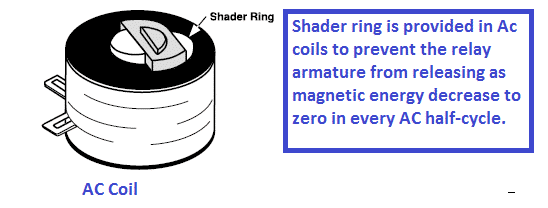What is a relay Coil? The relay coil has many turns of copper wire wound around a bobbin in which the iron core is situated. The resistance of the coil depends on the length of the wire and the cross-sectional area of the wire. When the voltage is applied across the coil, the coil sets up a magnetic field that attracts the armature. The armature controls contact movement. The AC and DC relays are different in construction.
The coil resistance of the AC and DC relay for the same voltage is different. The resistance of the AC coil is less as compared to the DC coil. The AC relay/contactor coil offers reactance when an AC supply is applied across it. The inductive reactance of the AC coil offers more impedance, and thus, it limits the current.
The AC coil has fewer turns than the DC coil.

The AC coil draws high initial current due to low inductance when the armature is open, and once the armature is closed, it requires a shader ring to retain the armature at the cross-over point to avoid chatter. Since alternating current decreases to zero every half-cycle, the relay armature tends to release magnetic energy in every half-cycle. This continual movement of the armature not only causes an audible “buzz” but will cause the contacts to open and close as the armature moves.
In order to operate a relay from AC, a shader ring or shader coil is placed on the top of the core. The magnetism developed in the part of the core lags somewhat with the remainder of the core, and, as a result, the phase displacement is established between the magnetism of the part of the core and the remainder of the core.
Thus, when the magnetic energy decreases to zero every half-cycle in the unshaded region, the magnetic energy is still present in the shaded region of the core, and when the magnetic energy decreases to zero in the shaded portion of the core, the unshaded magnetic energy starts to increase. In this way, the core remains magnetized throughout the cycle, and the chattering problem is avoided.
The DC relay has more turns of thin wires, and it offers high resistance. The resistance of the DC coil is kept more than that of the AC coil. This is because the resistance of the coil determines the current drawn by the DC coil. In the case of DC, the inductive reactance is zero.
The current of a DC relay is directly affected by the resistance of the coil. Ohm’s law governs the current in the DC coil . According to Ohm’s Law, for a given amount of resistance, current is directly proportional to voltage.
I = E/R
where;
I = current in amperes
E = voltage in volts
R = resistance in ohms
Thus, a 24-volt DC coil that has 240 ohms of resistance draws 0.1 ampere current. The DC relay has a slightly lower pull in time; however, once the armature is closed, the current required to keep the relay in a closed position is lower. In the DC relay, a shading ring is not required to avoid chattering.
The AC relay can be used with a DC supply with a series current limiting device.
1 thought on “Difference between AC and DC Relay”